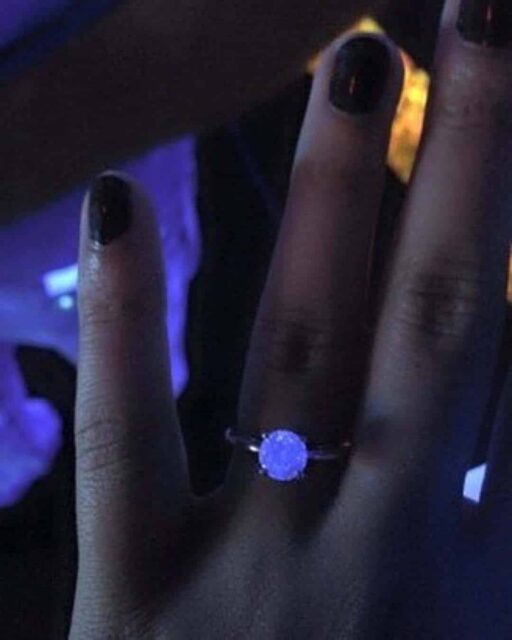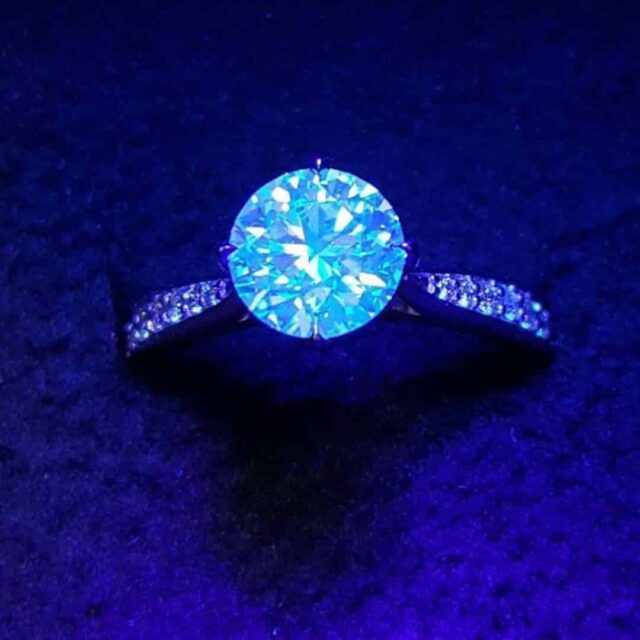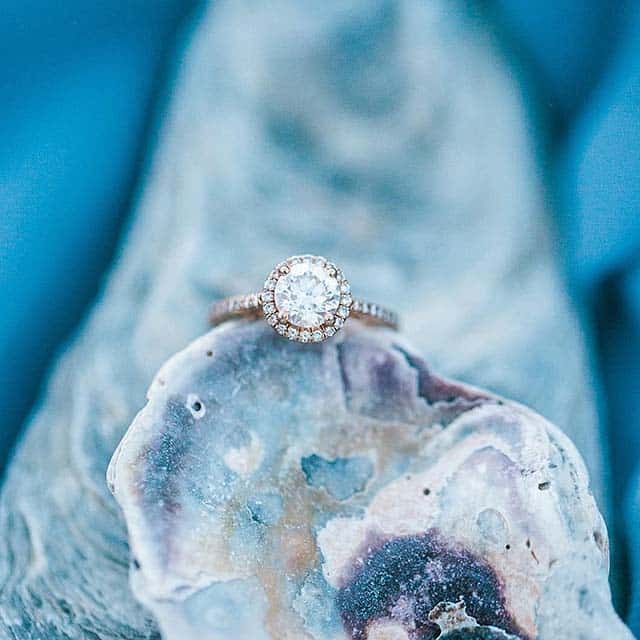Blue fluorescence in diamonds results from various degrees of boron, making them glow at different intensities when exposed to long-wave ultraviolet (UV) light. Approximately 25-35% of gem-quality diamonds exhibit fluorescence in colors such as blue, green, orange, red, yellow, and white.
In our experience, faint to strong blue fluorescence enhances a diamonds' appearance by filtering out the yellow undertones in white diamonds within the D-Z spectrum.
Fluorescent green, orange, and red diamonds are rare and reflect collection pricing. We recommend avoiding yellow and white fluorescent diamonds because they may negatively affect appearance.
Intensities of Diamond Blue Fluorescence:
Trained gemologists identify fluorescence by exposing diamonds to ultraviolet light in a pitch-black room. The diamonds are placed on a white plastic tray and examined from a side profile at approximately thirty degrees.
It's relatively easy to identify fluorescence under laboratory conditions when exposing diamonds to long-wave UV light. However, the effects of blue fluorescence are less obvious under normal viewing conditions. The following image from the GIA shows varying degrees of intensity as seen under long-wave UV light:

GIA Blue Fluorescence Grading Scale.
Effects of Blue Fluorescence:
As a general rule, faint blue fluorescence is of no consequence and is difficult to identify outside pitch-black laboratory conditions. In that case, it is not likely to affect diamonds' appearance to any visible degree.
Medium blue fluorescence is likely to improve the perception of diamond color when exposed to UV light, such as sunlight. Under those conditions, a colorless (D-E-F) and G-H-I-J) near-colorless diamonds appear white.
Strong blue fluorescence can improve the perception of diamond color up to one color grade when exposed to long-wave UV light. In other words, a G-color diamond with strong blue fluorescence may look more like F-color under certain lighting conditions.
Very strong blue fluorescence and the more extreme category known as over-blue may negatively impact appearance, especially in higher color grades, such as D-E-F colorless. In contrast, a higher degree of blue fluorescence may improve the appearance of lower color grades, such as I-J-K color and beyond.
It's essential to remember that most fluorescent diamonds look "perfectly normal" (white) unless exposed to black light. In that case, you're not likely to detect the presence of blue fluorescence under normal lighting conditions.
Does Blue Fluorescence Make Diamonds Look Cloudy/Hazy?
There seems to be a great deal of confusion about the effect of blue fluorescence upon diamonds' appearance, especially in the range of medium blue to strong blue.
On the one hand, there is the potential that blue fluorescence has to improve the perception of diamond color. On the other hand, there is the fear that it may cause diamonds to look cloudy, hazy, or milky.
According to a study by the Gemological Institute of America (GIA), fluorescence negatively impacts less than two percent of gem-quality diamonds. The 1997 statistical analysis reviewed a random sampling of 26,010 diamonds ranging in color from colorless to faint yellow.
Sixty-five percent of those diamonds exhibited no measurable degree of fluorescence when exposed to long-wave UV radiation. Of the 26,010 diamonds evaluated, 9,175 or 35%, showed fluorescence in the following intensities:
Of the 5,710 diamonds exhibiting medium to very strong fluorescence, 5,533 (97%) exhibited blue fluorescence. Only 162 of the diamonds (3%) fluoresced another color, such as yellow, white, or orange.
Note that the GIA does not indicate the color of faint fluorescent diamonds, but it's generally blue. Remember that faint fluorescence is generally of no consequence and unlikely to have any visual impact.
GIA's Research on Fluorescent Diamonds:
The GIA based their analysis on blue fluorescent diamonds because of "the difficulty of finding sufficient numbers of yellow fluorescent stones to conduct a parallel study."
They also state that "Diamonds with extremely strong blue fluorescence and a distinctive oily or hazy appearance, often referred to as 'overblues' are also a concern to the industry. In our experience, however, they are even rarer than diamonds with yellow fluorescence."
In our experience, it's unusual for blue fluorescence to negatively impact white diamonds' appearance. As stated previously, medium to strong blue fluorescence tends to improve the perception of diamond color.
Is Blue Fluorescence Good or Bad?
If it's any indication of where I stand on the subject, the 2.25-carat diamond Brian Gavin cut for my wedding ring was I-color with strong blue fluorescence. The setting and prongs were yellow gold, but the diamond looked white because of the blue fluorescence.
Consequently, the metal color touching the edge of the diamond can affect the appearance by one color grade. So, setting an I-color diamond in yellow gold prongs makes it look more like J-color while mounting the same diamond in white metal prongs makes it look closer to H-color.
In that case, the strong blue fluorescence made the diamond look whiter and brighter in the presence of long-wave UV light. Remember that the neon blue color is only visible under specific conditions, such as black light.
Choose diamonds with negligible, faint, medium, or strong blue fluorescence if you want to play it safe. Fluorescence negatively impacts less than two-percent of gem-quality diamonds, and those tend to be in the very strong to over-blue spectrum.
Are Fluorescent Diamonds Cheaper?
Many people wonder whether there is a discount for blue fluorescent diamonds because some consider it a negative characteristic. Meanwhile, others see the benefits of blue fluorescence and consider it a desirable trait.
Therein lies the answer to the question regarding discounts for diamonds with blue fluorescence. Some dealers might offer a discount for blue fluorescent diamonds, while others may charge a premium.
Beauty, as they say, lies in the eye of the beholder. Suffice to say that some dealers will discount colorless diamonds with medium to strong blue fluorescence and higher. In contrast, they may charge a premium for near-colorless and faint yellow diamonds with blue fluorescence.
Consequently, that does not mean that fluorescent diamonds are good or bad because no firm pricing guidelines exist. In that case, deciding to discount or charge a premium for fluorescence is a matter of preference. In our experience, the overall cut quality impacts diamond prices up to sixty percent, while fluorescence is a minor factor.
Should I Buy a Diamond with Blue Fluorescence?

Brian Gavin Blue Diamond Under Black Light.
Deciding whether to buy a blue fluorescent diamond is a matter of personal preference. First, determine whether you are comfortable with a diamond that will glow blue when exposed to black light.
This photograph shows a Brian Gavin Blue fluorescent diamond with medium blue fluorescence. If you like how it looks exposed to black light, then consider buying a blue fluorescent diamond.
Some people prefer diamonds with blue fluorescence, and others insist on negligible/none. Consequently, the GIA uses the term none, while the AGS prefers negligible to describe intensities less than faint.
Use our free diamond concierge service if you want help evaluating or searching for diamonds. We're happy to help whether you shop online or buy from your local retailer.



